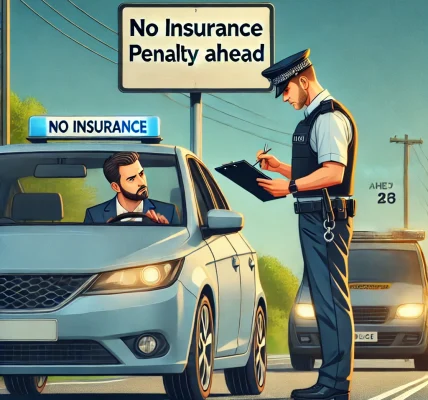Car insurance premiums vary from person to person, even if two individuals own the same type of vehicle. This difference is due to various factors that insurance companies consider when calculating your premium. Understanding these factors can help you make informed decisions and potentially reduce your car insurance costs.
In this DIY guide, we will explore the top 10 factors that affect your car insurance premium and provide tips on how you can manage them to get the best deal.
1. Your Driving Record
One of the most significant factors that impact your car insurance premium is your driving history. Insurance companies assess your past driving behavior to predict your future risk level.
How It Affects Your Premium:
✅ Clean driving record: Lower premiums due to reduced risk. ❌ Accidents & traffic violations: Higher premiums as you are considered a high-risk driver.
DIY Tip:
- Follow traffic rules and drive safely.
- Consider a defensive driving course to improve your driving skills and qualify for discounts.
2. Your Age and Experience
Younger and inexperienced drivers typically pay higher insurance premiums because they are statistically more prone to accidents.
How It Affects Your Premium:
✅ Experienced drivers (over 25 years old): Lower premiums due to a history of responsible driving. ❌ Young or new drivers (under 25 years old): Higher premiums due to increased accident risks.
DIY Tip:
- If you’re a young driver, consider being added to a parent’s policy to reduce costs.
- Gain experience by driving responsibly and maintaining a clean record.
3. Your Location
Where you live plays a crucial role in determining your car insurance premium. Insurance companies analyze factors like crime rates, traffic congestion, and accident frequency in your area.
How It Affects Your Premium:
✅ Low-crime, rural areas: Lower premiums. ❌ High-crime, urban areas: Higher premiums due to increased risk of theft and accidents.
DIY Tip:
- If possible, park your car in a garage to reduce the risk of theft.
- Consider installing anti-theft devices for additional discounts.
4. Type of Vehicle You Drive
The make, model, age, and safety features of your car influence your insurance cost. Expensive cars with high repair costs will result in higher premiums.
How It Affects Your Premium:
✅ Safe, affordable, and low-maintenance cars: Lower premiums. ❌ Luxury, sports, or high-performance cars: Higher premiums due to expensive repairs and theft risk.
DIY Tip:
- Choose a car with safety features like airbags, anti-lock brakes, and stability control.
- Consider insurance costs before purchasing a vehicle.
5. Annual Mileage (How Much You Drive)
The more you drive, the higher the risk of accidents, leading to higher premiums.
How It Affects Your Premium:
✅ Low-mileage drivers: Lower premiums. ❌ High-mileage drivers: Higher premiums due to increased accident risk.
DIY Tip:
- Use public transportation or carpool to reduce mileage.
- Ask your insurer about low-mileage discounts.
6. Type of Coverage and Deductibles
The level of coverage you choose and the amount of deductible you’re willing to pay impact your premium.
How It Affects Your Premium:
✅ Higher deductibles: Lower premiums (but more out-of-pocket expenses during claims). ❌ Lower deductibles & full coverage: Higher premiums.
DIY Tip:
- Increase your deductible if you can afford higher out-of-pocket expenses in case of a claim.
- Opt for only necessary add-ons to control premium costs.
7. Your Credit Score
In many countries, insurers use your credit score to determine how financially responsible you are. A higher credit score often results in lower insurance rates.
How It Affects Your Premium:
✅ Good credit score (700+): Lower premiums. ❌ Poor credit score (<600): Higher premiums due to perceived risk.
DIY Tip:
- Pay bills on time and reduce debt to improve your credit score.
- Check your credit report regularly for errors.
8. Previous Insurance History
A history of continuous insurance coverage without gaps helps reduce your premium.
How It Affects Your Premium:
✅ Consistently insured drivers: Lower premiums. ❌ Lapses in coverage: Higher premiums due to perceived higher risk.
DIY Tip:
- Avoid policy lapses by renewing your insurance on time.
- Maintain continuous coverage even if you don’t drive often.
9. Claim History
Frequent insurance claims indicate higher risk, leading to increased premiums.
How It Affects Your Premium:
✅ No-claim history: Lower premiums and potential no-claim bonuses. ❌ Multiple claims: Higher premiums due to increased risk.
DIY Tip:
- Avoid minor claims and pay for small damages yourself.
- Opt for a No-Claim Bonus (NCB) protection plan to retain discounts.
10. Add-Ons and Extras
Additional features like roadside assistance, zero depreciation cover, and engine protection increase your premium.
How It Affects Your Premium:
✅ Basic coverage: Lower premiums. ❌ More add-ons: Higher premiums.
DIY Tip:
- Only choose add-ons that are essential for your needs.
- Compare different providers to find the best coverage at affordable rates.
Conclusion
Understanding these top 10 factors that affect car insurance premiums can help you take control of your costs. Here’s a quick recap of how to reduce your premium:
✅ Drive safely and maintain a clean driving record. ✅ Choose your car wisely, considering insurance costs before buying. ✅ Reduce annual mileage where possible. ✅ Maintain a good credit score. ✅ Avoid frequent insurance claims. ✅ Park in secure locations and install anti-theft devices. ✅ Compare multiple insurance providers before purchasing a policy.
By following these simple steps, you can lower your car insurance premium while ensuring adequate protection for your vehicle. Always research, compare policies, and make informed decisions when selecting car insurance. 🚗💡


